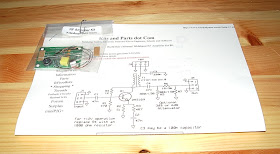 |
| LCD UI module ready for assembly |
On opening the envelope I was taken by surprise as I hadn't realized the module was a kit. But there aren't too many components and they are all through-hole so I should be able to manage it. I will take my time and double check everything to ensure I don't do anything stupid like solder headers on the wrong side of the board. More than a few K2 builders have done that!
The instructions on the Gadget Gangster website are very comprehensive with several colour photos showing different stages of assembly. But on checking the parts against the parts list I found that I was missing one 2x8-pin header socket. Fortunately I found one (a pack of 2 actually) for a couple of quid from a UK based eBay component supplier so I should have it in a couple of days. eBay is my main source of electronic components these days as the usual sources like Farnell or Maplin all have hefty minimum order and postage charges that make ordering the single part you need to complete a project quite uneconomic.
 |
| Kits and Parts Universal RF Amplifier |
Another new arrival in the G4ILO shack was a GPS module from Hong Kong. This was used, ex-equipment, and cost about £12 including postage. I'm not sure what I am going to use it for but if I don't put it in the beacon to provide a time reference (and locator) for WSPR it would be interesting to try to make an APRS tracker using the Propeller chip.
So many projects! But I am convinced that having this amateur radio hobby to give me so many different and interesting activities is the reason I remain cheerful and positive unlike so many people who have the same health condition and seem to fall into a slough of despond and hopelessness. I may never complete them but at least they give me something to stop me dwelling on darker thoughts.

I built up a Gadget Gangster UI board on Thursday. Mine was also missing the socket. It's easy to build and worked straight away.
ReplyDeleteI am going down the DDS route for signal generation. The Prop can drive that easily (I hope).
Good luck with the GPS. Still awaiting mine.
73
Richard
G3CWI
If you ar going to use the kitsandparts amp in "key down" transmitter applications be sure and put a heatsink on the transistor. I saw off three 2n5109 before I worked it out. Since fitting the heatsink i have had no further losses in my three arduino/PIC qrss/wspr beacons
ReplyDeleteDave
G4FRE
Dave, thanks for the warning. I'm not sure that I would have thought of that.
ReplyDeleteRichard, I don't know if your GPS module is the same as the one I've got but I noticed a disparity between the info supplied by the vendor and the PDF data sheet. The vendor says it will take a 5V supply but the data sheet specifies 3.3V max.
That's not all that's odd. The PDF shows a photo with a PPS o/p whereas the device that has just arrived does not seem to have PPS - which is a nuisance.
ReplyDelete3.3V is fine - same as the prop chip.
Cheers
Richard
The other aspect to note is low pass filtering, as K07M has pointed out in his pages. One dds has a 2nd harmonic only 22dB down on the fundamental so a low pass filter is essential especially with the 2N5109 after it!
ReplyDeleteIn my single frequency (non hopping) MEPT manually switched LPF are fine. I have used the hf projects 50W manual switched version
for band hopping MEPT I have used the relay switched 100W LPF from hfprojects in one and the relay switched LPF board from a TS850, obtained on ebay for 10 pounds for the other
There are pictures of the final MEPS on my web site g4fre.com/radio